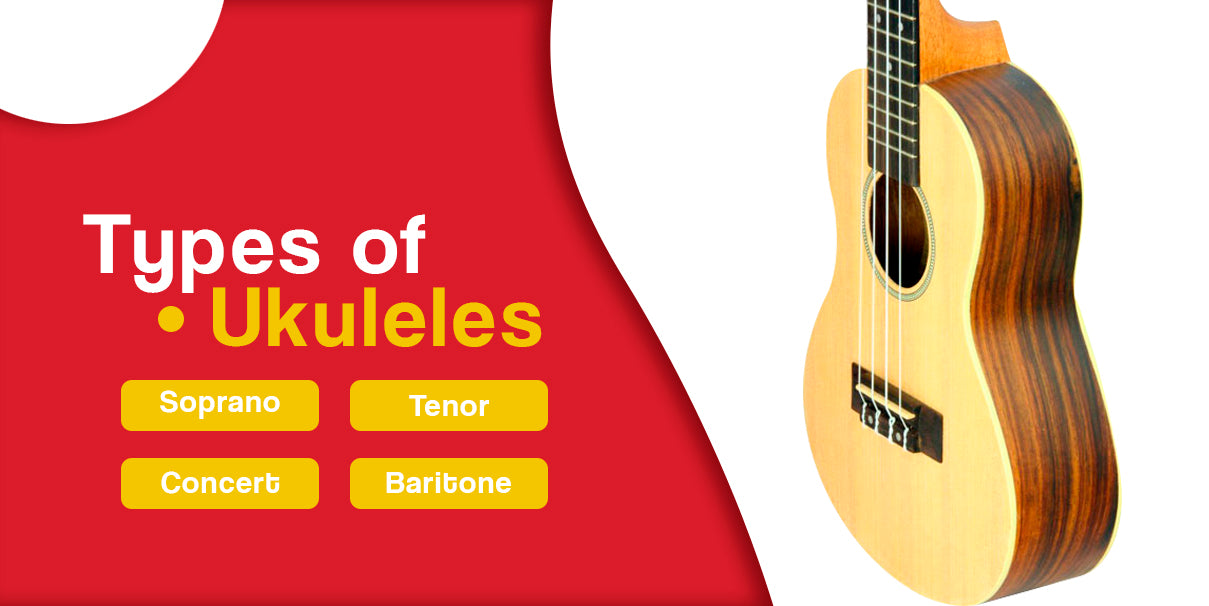
Guide to Buying a Ukulele
Seen in the hands of respected artists like Paul McCartney, Jason Mraz, Eddie Vedder and Jack Johnson, the ukulele is certainly making a comeback in the music world. Once disregarded as a novelty, these small stringed instruments have gained popularity in recent years as a serious musical instrument. Their distinctive and unique sound make ukuleles an excellent addition to any guitar player's collection.
With just four strings and a small fretboard, ukuleles are also excellent instruments for beginner musicians or children learning to play guitar. Whatever your reason for buying a ukulele, this guide will help you navigate the various types and styles of ukuleles to find the right one for you.
A Brief History of the Ukulele

While many people associate the ukulele with Hawaii, the story of this tropical stringed instrument actually begins on an island off the coast of Portugal. The small mountainous island of Madeira was known for its timber industry, wine-making skill and abundance of street music that entertained European tourists day and night. One instrument many people played on the island was a small four-stringed instrument called a machête, which likely evolved from the Spanish guitar.
During a period of economic hardship in the mid-1800s, thousands of Madeirans immigrated to Hawaii to work on sugar plantations and factories that were booming following the industrial revolution. Among these immigrants were three skilled furniture-makers who began producing machêtes and other stringed instruments on the island.
Hawaiian natives loved the sweet sound the machêtes produced, and even King Kalakaua was an avid supporter of the new instrument. This led to the creation of the ukulele in the 1880s as Hawaiians took up the instrument and created their own musical style. The name ukulele means "jumping flea" in Hawaiian and is said to describe the fast motion of the players' hands. Original ukuleles were carved out of Koa, a native Hawaiian wood, and tuned differently than their Portuguese cousins.
Ukuleles quickly spread to the mainland United States in the 1920s, as American musicians produced songs with Hawaiian themes. The ukulele became popular on Vaudeville stages and in Jazz in the 1950s. However, the rapid popularity of the ukulele would also lead to its downfall, as U.S. manufacturers began mass producing inexpensive plastic ukuleles to keep up with the trend. These cheaply made ukuleles produced poor sound, creating the perception that the ukulele was a toy and not a serious instrument.
While this negative perception remained through the latter half of the century, the 1990s brought a new wave of ukulele supporters. Israel Kamakawiwo'ole's ukulele medley of “Over the Rainbow” and “What a Wonderful World” became a hit in television ads and movies, and professional ukulele performers, such as Jake Shimabukuro and James Hill, have shown the world that the ukulele is an instrument to be taken seriously.
Types of Ukuleles

When choosing a ukulele, the first thing to consider is which type of ukulele you want. There are four main types of ukuleles: soprano, concert, tenor and baritone. While size is the defining feature of these types, each type of ukulele also has differences in tone and playability. Here are the four main types of ukuleles and their defining characteristics.
1. Soprano
The soprano ukulele was the original size of ukulele and is sometimes referred to as a "standard" ukulele. At 21 inches long with a 13-inch scale length, the soprano ukulele is the smallest traditional size of ukulele. Soprano ukuleles produce a bright and shimmering tone that is traditionally associated with ukuleles and tend to be quieter than larger ukuleles when not amplified. Soprano ukuleles are typically tuned at G4-C4-E4-A4, which is also the standard tuning for concert and tenor ukuleles.
Compact and light, soprano ukuleles are an excellent option for those with smaller fingers or children just starting out. The short distance between frets makes it easy to play notes without stretching. Their distinctive ukulele sound also makes soprano ukuleles desirable to many players.
2. Concert
One step larger than the soprano ukulele is the 23-inch concert ukulele. With a 15-inch scale length, concert ukuleles are slightly deeper and louder than soprano ukuleles, while still retaining the classic ukulele sound.
Concert ukuleles are typically tuned at G4-C4-E4-A4, but can also be found in G3-C4-E4-A4 or A4-D4-F#4-B4 tuning. Concert ukuleles are the perfect choice for those seeking the traditional bright and light ukulele sound, but who find a larger distance between frets more comfortable. The longer scale length of concert ukuleles can make them easier to play for those with larger hands.
3. Tenor
A popular choice for professional ukulele players, tenor ukuleles offer a comfortable scale length of 17 inches and overall length of 26 inches. Tenor ukuleles produce a deeper and more resonant sound than smaller ukuleles. Their tone can be described as rich and warm, and their large body size allows them to create more volume without amplification.
Tenor ukuleles are typically tuned the same as soprano and concert ukuleles, but can also be tuned in G3-C4-E4-A4, D4-G3-B3-E4 or A4-D4-F#4-B4. Some players prefer tenor ukuleles because the larger size makes it easier to play pieces that require quick finger movement.
4. Baritone
The largest instrument in the ukulele family, the baritone ukulele is 30 inches long with a scale length of 19 inches. Baritone ukuleles are tuned at D3-G3-B3-E4, which is the same standard tuning as an acoustic guitar's top four strings. For this reason, the baritone ukulele can produce deeper bass notes and a sound similar to a classical guitar with nylon strings. The unique tuning of the baritone ukulele also means players will use different musical arrangements than those playing smaller ukulele types.
Baritone ukuleles are an excellent choice for musicians transitioning from playing guitar, as the tuning is familiar. The comparatively smaller size allows guitar players to adjust to the shorter frets without having to learn an entirely new set of notes. Baritone ukuleles can also be a great choice for adults who are learning ukulele, as its large size makes it easier to play if you have larger fingers.
Specialty Ukuleles
Aside from the four common types of ukuleles, there are a few unique styles of ukuleles available. For a skilled musician or ukulele fanatic, these specialty ukuleles can be an exciting way to expand your instrument collection. Here are a few specialty ukuleles you may encounter on the market today:
- Banjo Ukuleles: With a banjo-style body and fretted ukulele neck, these quirky instruments were first popular in the early 1900s with performers on Vaudeville. Banjo ukuleles are commonly the same size as a soprano or concert ukulele and are also tuned in G-C-E-A. Banjo ukuleles have a sharp attack and fast decay with the signature twang of a banjo. Just as ukuleles can be a stepping stone to learning guitar, banjo ukuleles can be a great introduction to the classic American banjo. You may find banjo ukuleles marketed under a few other names, including bangolele, banjolele, banjulele or banjo uke.
- Bass Ukuleles: This recent development in the music industry is a powerful ukulele that can produce the heavy, low-end notes to resemble the sound of a bass guitar. Bass ukuleles are about the same size as baritone ukuleles and use thick polyurethane strings to produce deep plucky tones. Bass ukuleles are available with hollow or solid bodies and a variety of other modifications. Bass ukuleles are a great option for bass players seeking a more portable instrument.
Acoustic vs. Acoustic/Electric Ukuleles
Similarly to guitars, ukuleles are available in acoustic and electric options. While purely electric ukuleles are more of a niche instrument, acoustic and acoustic/electric ukuleles are both popular choices for ukulele players. Here are a few differences between these two types of ukuleles:
- Acoustic Ukuleles: Acoustic ukuleles are the most common type of ukulele and tend to require less maintenance than acoustic/electric ukuleles. Acoustic ukuleles are perfect for those who play as a hobby because they're only able to produce a limited volume of sound. If amplification is needed for an acoustic ukulele, such as during a performance, you can use an external soundhole pickup or microphone. You can also modify acoustic ukuleles with an added electric pickup if you decide to add amplification capabilities in the future.
- Acoustic/Electric Ukuleles: Because they have onboard electronics, acoustic/electric ukuleles can be plugged directly into amps. Acoustic/electric ukuleles are great for live performances and recording music in a studio. Acoustic/electric ukuleles can also be played without amplification and still produce a beautiful acoustic sound. If you plan to perform or record in the future, investing in an acoustic/electric ukulele may be the right choice for you.
Ukulele Body Styles
Ukuleles are available in a few body styles, with the figure 8 style being the most popular. While the body style has a subtle impact on the tone of the instrument, the main distinction is their visual appeal. Figure 8 guitar body styles also offer the option of a cutaway that is not possible with pineapple shaped ukuleles.
Here are a few differences between the common ukulele body styles:
- Pineapple: The Kamaka Ukulele Company created this unique ukulele shape in the mid-1920s. With a rounded back and oval shape, these ukuleles are a similar shape to pineapples and were initially painted to resemble the tropical fruit. Pineapple ukuleles have a slightly larger body than figure 8 ukuleles and thus produce a more resonant and mellow sound. Pineapple ukuleles can also achieve more volume without amplification.
- Figure 8: This traditional ukulele shape is also known as guitar shape, as it resembles the shape of an acoustic guitar with a smaller upper bout and larger lower bout. While the waist of the ukulele does not serve a function as it does with a guitar, the figure 8 shape was still retained when the ukulele evolved from the machête. This is the most common ukulele shape and is widely available in both acoustic and acoustic/electric models.
- Cutaway: Some figure 8 ukuleles feature a cutaway that removes a portion of the upper bout, making it easier to reach the higher frets. This body style is more common with acoustic/electric models but can be found in acoustic ukuleles, as well. Most ukuleles do not have cutaways, and the majority of players will not need to use a cutaway ukulele to play comfortably. However, if you plan to perform or anticipate playing music in higher registers, you may want to consider a ukulele with a cutaway.
No matter which body style you choose, pay attention to the build and construction of the instrument before you buy. Because ukuleles are so small, some instruments will be constructed with a headstock that is too heavy for the body. Look for a ukulele with a lightweight body and build that is evenly balanced.
Solid Wood vs. Laminate Wood
Ukuleles are constructed with either solid wood or laminate wood, with either construction available with a variety of different types of wood. While the type of wood has a larger impact on the tone of the ukulele, the composition of the wood impacts the overall quality and durability of the instrument.
Here are a few benefits of each type of ukulele:
- Solid Wood Ukuleles: Because they are built with solid pieces of wood, these ukuleles are often more resonant than laminate wood ukuleles and can provide a higher quality tone. Solid wood instruments will also mellow with age to produce a richer sound over time, while laminate wood instruments will sound the same throughout their life. Because of their delicate construction, solid wood ukuleles can be easier to damage but will last a long time when you take care of it.
- Laminate Wood Ukuleles: Laminate wood ukuleles are created with several thin layers of wood glued together, making them more affordable and durable than solid wood ukuleles. Laminates are less prone to splitting or cracking, which can be a concern for wooden instruments when played in dry or cold climates. Laminate ukuleles sealed with a thick finish will have high durability for use outdoors or while traveling. Some laminate ukuleles have a laminate body with a solid tonewood top, which creates a richer and warmer tone than an instrument built solely with laminate.
Types of Wood for Ukuleles

The overall sound quality of a ukulele will depend on many factors, including the body style, size of the instrument, type of strings and the skill level of the musician. However, the kind of wood the instrument is built with plays a significant role in determining a ukulele's tonal qualities. While there is no perfect wood for a ukulele, each option offers its own nuances and unique sound.
Here are a few of the most common types of wood used for ukuleles and their defining qualities:
- Koa: This dense tropical wood is native to Hawaii and was the original wood used to build the first ukuleles. Koa wood produces a balanced and warm tone with a focused, pleasant middle range. With defined grain patterns and a wide range of colors available, koa wood ukuleles are beautiful in both appearance and sound. Because they are botanically related, acacia wood can also produce similar tones to koa.
- Mahogany: Because it is widely available, mahogany is a popular wood for ukuleles. Mahogany wood is somewhat softer than koa and produces a darker and warmer tone with a full low end and rich middle range. Mahogany ukuleles are balanced with a rounded tone on the top end.
- Spruce: A common wood used for guitar tops, spruce has become a popular choice for ukuleles, as well. The dense grain of spruce creates bright and loud tones with an accentuated and articulate top end and dynamic middle range. When used as a ukulele top, this softer wood helps to produce a louder sound.
- Cedar: Even softer than spruce, cedarwood brings out the lower end tones and produces a round and mellow sound. For this reason, cedar is an excellent choice for tenor and baritone ukuleles. Cedar ukuleles are often very responsive to lighter plucking and strumming and create beautiful harmonics.
- Maple: Another wood that is popular in guitar construction, maple has carried over to ukulele construction, as well. Because it is a hard wood, maple is often used for fretboards and bridges. Maple offers a balanced middle range and fast note decay.
- Rosewood: This dense wood is commonly used on ukulele fretboards, but can also be used for the ukulele body. Rosewood provides a rich red coloring and offers a robust low end with complex overtones.
Different wood choices will also offer unique colors, finishes and grain patterns that impact the aesthetic appeal of the instrument. Painted wood ukuleles are also available in bright colors and patterns. However, when shopping for a ukulele, be sure to follow your ears, not your eyes. Focus on finding the sound you want first, then choose an instrument that appeals to your style visually.
Ukuleles From Bananas at Large

Whether you are looking for an affordable beginner ukulele or a high-end performance model, Bananas at Large offers high-quality ukuleles in every price range. Browse our ukulele selection, including Gretsch, Amahi, Lanikai, and Kala, to find the size and style you want, or visit a Bananas location, and our dedicated team would be happy to help find the perfect ukulele for you. Test a variety of models to find the sound you want and a ukulele that is comfortable and enjoyable to play.
For budding musicians or anyone looking to hone their skill, Bananas at Large also offers ukulele lessons to help get you started, so you can fall in love with your new ukulele in no time.










